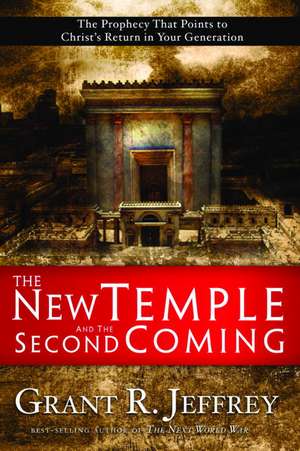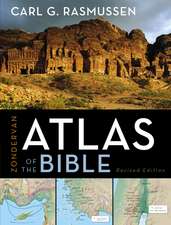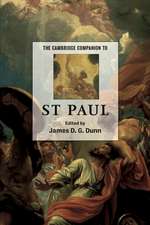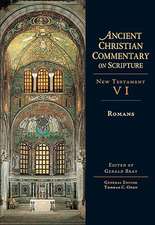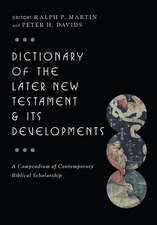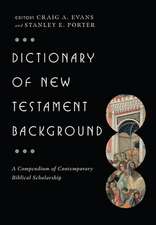The New Temple and the Second Coming: The Prophecy That Points to Christ's Return in Your Generation
Autor Grant R. Jeffreyen Limba Engleză Paperback – 30 sep 2007
The evidence–uncovered by prophecy expert Grant R. Jeffrey–is breathtaking: Jewish authorities are preparing to rebuild the Temple in Jerusalem. Quietly they have recovered lost artifacts from the ancient Temple and have recreated sacred worship vessels. The new Sanhedrin, now reconvened in Israel, is training Levite priests to reinstitute animal sacrifice. These remarkable developments have far-reaching prophetic significance.
In this book you will examine the biblical prophecies and research data that together solve end-times mysteries, including:
·The search for lost Temple treasures
·Revealing discoveries in underground Jerusalem
·The process of recreating sacred Temple vessels
·Unexpected clues revealed in the Copper Scroll and the Ezekiel Tablets
·The latest plans for rebuilding the Temple
Join Dr. Jeffrey as he uncovers answers to questions that have perplexed students of prophecy for centuries. Answers that point to the unmistakable conclusion that this is truly the last generation.
Preț: 106.12 lei
Nou
Puncte Express: 159
Preț estimativ în valută:
20.31€ • 21.12$ • 16.77£
20.31€ • 21.12$ • 16.77£
Carte disponibilă
Livrare economică 25 martie-08 aprilie
Preluare comenzi: 021 569.72.76
Specificații
ISBN-13: 9781400071074
ISBN-10: 1400071070
Pagini: 224
Ilustrații: PHOTOS, MAPS, CHARTS, DIAGRAMS
Dimensiuni: 160 x 228 x 15 mm
Greutate: 0.29 kg
Editura: Waterbrook Press
ISBN-10: 1400071070
Pagini: 224
Ilustrații: PHOTOS, MAPS, CHARTS, DIAGRAMS
Dimensiuni: 160 x 228 x 15 mm
Greutate: 0.29 kg
Editura: Waterbrook Press
Notă biografică
Grant R. Jeffrey is the internationally known author of The Next World War and more than twenty other bestselling books, and the editor of the Marked Reference Prophecy Study Bible. His popular TV program, “Bible Prophecy Revealed,” airs twice a week on Trinity Broadcasting Network. Jeffrey earned his Master’s and PhD degrees from Louisiana Baptist University. He and his wife, Kaye, live in Toronto.
Extras
Introduction: Rebuilding the Temple
The Countdown to Christ’s Return
Watchman, what of the night?
Watchman, what of the night?
The watchman said, The morning cometh, and also the night: if ye will enquire, enquire ye: return, come.
Isaiah 21:11-12
Almost two thousand years ago, after nearly two years of terrible siege, the brutally efficient legions of Rome destroyed Jerusalem and burned the Temple to the ground. Led by General Titus, the son of Emperor Vespasian, the Roman army completed its mission of destruction on the ninth day of Av (August) in AD 70.
The glorious Temple, built by King Herod, was the second of the sacred Temples to stand on the Temple Mount in Jerusalem. The First Temple had been built by King Solomon around 1000 BC and was destroyed by the Babylonians in 586 BC. The Second Temple, built initially by the Jews after their return to Jerusalem in 536 BC following the Babylonian captivity and then expanded by Herod in the first century, remains in ruins today. However, exciting developments are taking place in Israel that will result in a Third Temple being built on the ancient foundations that Solomon put in place more than three thousand years ago.
You and I are part of the generation that will live to see a Temple of God once again stand in Jerusalem, the spiritual crossroads of the world.
The rebuilding of the Temple holds profound prophetic significance, equal to the appearance of the Antichrist or the forming of the pagan armies to invade Israel in the coming War of Gog and Magog. While many students of biblical prophecy have debated the role that will be played by the Third Temple in end-times developments, the Scriptures make it clear that just before Christ returns, the Third Temple of God must stand again on the original location on the Temple Mount.
Preparations to rebuild the Temple have progressed on several fronts, with plans already in place that go into far greater detail than most people are aware of. The Temple project is yet another major prophetic signpost on the time line leading to the final conflict of the battle of Armageddon and the establishment of the kingdom of God. No less a prophet than Jesus Christ made it clear that the generation that witnessed the return of the Jews to the Promised Land would live to see Him return to earth. The modern State of Israel was born in 1948, which means that you and I are part of the last-days generation (see Matthew 24:32—34).
However, the Temple must once again occupy its place on the Temple Mount before the major prophesied events of the last days can take place.
Many scholars have questioned whether the Temple will ever be rebuilt because of the immense practical, religious, and political obstacles that stand in the way. Mosques, shrines, and other Muslim holy sites occupy the Temple Mount, a thirty-five acre site that is under the administrative control of Arab authorities. Since the Six-Day War in 1967, Israel has controlled the entire city of Jerusalem, including the Temple Mount. However, Israel allows the Supreme Muslim Religious Council (the Waqf ) to control religious activities and to police (without firearms) all activities on the Temple Mount. This area is the location of the Dome of the Rock and the Al-Aqsa Mosque. Religious Jews do not worship in the area of the Dome of the Rock because the chief rabbis warn they might inadvertently trespass on the site of the ancient Holy of Holies. Muslim control of the Temple Mount fulfills the prophecy of Luke 21:24, that “Jerusalem shall be trodden down of the Gentiles, until the times of the Gentiles be fulfilled.”
In addition to the political and religious tensions that stand in the way of rebuilding the Temple, a longstanding and seemingly unsolvable dilemma from within Judaism has presented a major obstacle. The Jews cannot rebuild the Temple or resume worship in the Temple unless the long-dormant Sanhedrin Court, the highest body of Jewish lawmakers, is reconvened. This is necessary in order to reestablish the Levitical priesthood. The Sanhedrin is the only religious body authorized to determine the correct location of the Temple, to reinstitute the ancient rituals, and to oversee the many details related to Temple ritual and worship.
One of Jesus’ prophecies indicates that the Sanhedrin will indeed be fulfilling its duties in the last days. Christ warned His disciples about the coming persecution in Jerusalem during the Tribulation. He told them to pray that their flight from the city would not be “on the sabbath day” (Matthew 24:20).
The reason for this is the commandment against performing work on the sabbath (see Exodus 20:8—10). The ancient Sanhedrin had determined that any travel on the sabbath that exceeded one thousand paces was considered work. However, if an invasion force should attack on the sabbath and the Jews in Jerusalem limited their travel to one thousand paces, it could ensure their destruction. Christ’s prophecy implies that the Sanhedrin will exist in the last days and will have the authority to enforce such a religious rule. The historian Flavius Josephus calculated the distance from the Temple Mount to the Mount of Olives, known popularly as “the sabbath’s day journey,” as approximately one thousand yards.
Interestingly, the gospel historian Luke wrote in the book of Acts that the distance from the Mount of Olives to the Temple Mount is approximately a thousand paces, a “sabbath’s day journey” (1:12).
Israel without a Temple
With the destruction of the Second Temple in AD 70, Israel lost the Temple as the center of its spiritual life (see photograph). During the nineteen centuries that followed, Jews in exile prayed for their prophesied return to the Promised Land. Every year at Passover and at the end of Yom Kippur, righteous Jews have prayed, “Next year in Jerusalem.” Along with that hope, religious Jews have longed to rebuild their Temple and establish the long-promised kingdom of God on earth under the rule of the long-awaited Messiah.
Over those same centuries, three times a day devout Jews living in exile have prayed that they will live to see their Temple rebuilt: “May it be Thy will that the Temple be speedily rebuilt in our days.”2 They looked forward to the day when the Temple would once again stand on the Temple Mount.
They longed for the Lord to return His Shekinah Glory and Divine Presence to the sanctuary in Jerusalem. Finally, after nineteen centuries, today’s generation has been given the task of making these ancient dreams come true.
God’s Command to Build a Sanctuary
The rebuilding of the Temple is central to the messianic hopes of the Jewish people. As the rabbis have noted, God never rescinded His command that Israel build a sanctuary for Him (see Exodus 25:8). Therefore, His command remains in force today.
The Lord gave Moses the precise blueprint to follow in constructing His earthly sanctuary, the movable Tabernacle that Israel used prior to the building of the First Temple. The sacred vessels and worship instruments that later were used in Solomon’s Temple, including the ark of the covenant.
Likewise, God revealed to King David and his son Solomon the detailed plans for building a permanent Temple on Mount Moriah in Jerusalem. Solomon’s Temple was destroyed in 586 BC. The Second Temple, initially completed in 516 BC and totally refurnished and enlarged by King Herod beginning in 18 BC, was destroyed as well, in AD 70. Yet Jesus mentioned the existence of “the holy place” in a future Temple when He told His disciples about the events of the last days and the Great Tribulation.
He warned that “when ye therefore shall see the abomination of desolation, spoken of by Daniel the prophet, stand in the holy place, (whoso readeth, let him understand:) then let them which be in Judaea flee into the mountains” (Matthew 24:15—16). Jesus’ prophecy echoed that of the prophet Daniel, who indicated that the “abomination that maketh desolate” would stand in the Temple of God in Jerusalem (see Daniel 11:31; 12:11). Both prophecies suggest that the Third Temple will be built before the Antichrist comes to power and takes control of Europe and the surrounding Mediterranean nations.
Satan will spiritually defile the Holy Place of the rebuilt Temple by directing his Antichrist to violate the Holy of Holies at the beginning of the last three and a half years of the Tribulation. The False Prophet, the Antichrist’s partner, will then demand that the Antichrist be worshiped as “god” in the rebuilt Temple.
Controversy over Rebuilding the Temple
Among the ongoing tragedies of the Middle East is that both Arabs and Jews claim the right of possession of the Holy Land, the city of Jerusalem, and the Temple Mount. In just about any current news report involving the conflict between Israel and its Arab enemies, the ancient, walled Old City of Jerusalem plays a prominent role. God told His prophets thousands of years ago that the final battle for the soul and destiny of mankind will be decided in Jerusalem, whose name literally means “city of peace,” the city where the coming Messiah will establish His eternal throne.
The Third Temple will be built on what is the most passionately contested piece of real estate on earth. Not only is this rebuilding prophesied in Scripture, but today rabbis, researchers, archaeologists, and other interested parties are drawing up detailed architectural plans, re-creating precious vessels to be used in Temple worship, and searching for the lost treasures of the ancient Temple. Incredible progress has been made recently in locating, gathering, and in some cases re-creating the necessary vessels, utensils, and other sacred objects that will be necessary to reinstate sacred worship and animal sacrifice.
Key figures of the Orthodox Jewish leadership in Israel have finally thrown their support behind the many efforts currently under way to prepare for building the Third Temple. The progress, extent, and timing of these preparations will be examined in later chapters of this book.
Control of the Temple Mount
After Israel’s stunning victory over the Arab armies during the Six-Day War in June 1967, Israeli defense minister General Moshe Dayan went to the Al-Aqsa Mosque to meet with the five leaders of the Supreme Muslim Religious Council. The council had exercised control over the Temple Mount during nearly twenty years of Jordanian military control of the eastern portion of Jerusalem, from Israel’s 1948 War of Independence until the Six-Day War. The meeting between Dayan and the Muslim leaders established Israel’s religious and political policy concerning the Temple Mount, a policy that remains unchanged today. Dayan, a nonreligious Jew, did not appreciate the profound historical and spiritual significance of the Temple Mount and thus relinquished administrative control to the Arabs. He hoped the generosity of this gesture would be appreciated. Unfortunately, they interpreted it as an indication of the weakness of Israel’s resolve to possess and hold their holiest place of worship, the Temple Mount.
Dayan ordered the Israeli flag that Jewish soldiers had affixed to the golden dome removed from the Dome of the Rock. His further concessions surrendered administrative control of the Temple Mount to the Supreme Muslim Religious Council, a Jordanian-controlled Muslim trust known as the Waqf. Though Jews would be permitted limited access to the Temple Mount area, all prayer or reading of Scripture by Jews and Christians was prohibited.
The Temple Mount remains at the center of Israeli-Arab tensions, with Arab authorities continuing to exercise administrative control over Israel’s most sacred site. However, God has called on His people to rebuild the Temple. Not only is this critical development commanded by God, but the Scriptures reveal that the Temple will be rebuilt before the Messiah returns to earth.
In the chapters that follow, we will look not only at the advancing plans and preparations to rebuild the Temple, but also at a number of closely related developments, such as the training of Levite priests, the recovery of long-lost Temple treasures, developments in locating the ark of the covenant and returning it to Jerusalem, and the discovery of ancient vessels and artifacts that are required for Temple sacrifice and worship. With a new Sanhedrin Court now in place, with some five hundred Levites being trained in the requirements of Temple animal sacrifice, and with critical lost treasures from the Second Temple being located and returned to Jerusalem, it is no longer just a dream that the Temple of God will once again stand on the Temple Mount.
After nineteen centuries of praying and waiting, the Jews have finally been given the historic task of making their ancient dreams come true. The building of the Third Temple will commence much sooner than most people expect. The generation alive today will see the Temple of God once again standing in Jerusalem, and the King of Israel–the returning Messiah–ruling from the throne of David!
The Countdown to Christ’s Return
Watchman, what of the night?
Watchman, what of the night?
The watchman said, The morning cometh, and also the night: if ye will enquire, enquire ye: return, come.
Isaiah 21:11-12
Almost two thousand years ago, after nearly two years of terrible siege, the brutally efficient legions of Rome destroyed Jerusalem and burned the Temple to the ground. Led by General Titus, the son of Emperor Vespasian, the Roman army completed its mission of destruction on the ninth day of Av (August) in AD 70.
The glorious Temple, built by King Herod, was the second of the sacred Temples to stand on the Temple Mount in Jerusalem. The First Temple had been built by King Solomon around 1000 BC and was destroyed by the Babylonians in 586 BC. The Second Temple, built initially by the Jews after their return to Jerusalem in 536 BC following the Babylonian captivity and then expanded by Herod in the first century, remains in ruins today. However, exciting developments are taking place in Israel that will result in a Third Temple being built on the ancient foundations that Solomon put in place more than three thousand years ago.
You and I are part of the generation that will live to see a Temple of God once again stand in Jerusalem, the spiritual crossroads of the world.
The rebuilding of the Temple holds profound prophetic significance, equal to the appearance of the Antichrist or the forming of the pagan armies to invade Israel in the coming War of Gog and Magog. While many students of biblical prophecy have debated the role that will be played by the Third Temple in end-times developments, the Scriptures make it clear that just before Christ returns, the Third Temple of God must stand again on the original location on the Temple Mount.
Preparations to rebuild the Temple have progressed on several fronts, with plans already in place that go into far greater detail than most people are aware of. The Temple project is yet another major prophetic signpost on the time line leading to the final conflict of the battle of Armageddon and the establishment of the kingdom of God. No less a prophet than Jesus Christ made it clear that the generation that witnessed the return of the Jews to the Promised Land would live to see Him return to earth. The modern State of Israel was born in 1948, which means that you and I are part of the last-days generation (see Matthew 24:32—34).
However, the Temple must once again occupy its place on the Temple Mount before the major prophesied events of the last days can take place.
Many scholars have questioned whether the Temple will ever be rebuilt because of the immense practical, religious, and political obstacles that stand in the way. Mosques, shrines, and other Muslim holy sites occupy the Temple Mount, a thirty-five acre site that is under the administrative control of Arab authorities. Since the Six-Day War in 1967, Israel has controlled the entire city of Jerusalem, including the Temple Mount. However, Israel allows the Supreme Muslim Religious Council (the Waqf ) to control religious activities and to police (without firearms) all activities on the Temple Mount. This area is the location of the Dome of the Rock and the Al-Aqsa Mosque. Religious Jews do not worship in the area of the Dome of the Rock because the chief rabbis warn they might inadvertently trespass on the site of the ancient Holy of Holies. Muslim control of the Temple Mount fulfills the prophecy of Luke 21:24, that “Jerusalem shall be trodden down of the Gentiles, until the times of the Gentiles be fulfilled.”
In addition to the political and religious tensions that stand in the way of rebuilding the Temple, a longstanding and seemingly unsolvable dilemma from within Judaism has presented a major obstacle. The Jews cannot rebuild the Temple or resume worship in the Temple unless the long-dormant Sanhedrin Court, the highest body of Jewish lawmakers, is reconvened. This is necessary in order to reestablish the Levitical priesthood. The Sanhedrin is the only religious body authorized to determine the correct location of the Temple, to reinstitute the ancient rituals, and to oversee the many details related to Temple ritual and worship.
One of Jesus’ prophecies indicates that the Sanhedrin will indeed be fulfilling its duties in the last days. Christ warned His disciples about the coming persecution in Jerusalem during the Tribulation. He told them to pray that their flight from the city would not be “on the sabbath day” (Matthew 24:20).
The reason for this is the commandment against performing work on the sabbath (see Exodus 20:8—10). The ancient Sanhedrin had determined that any travel on the sabbath that exceeded one thousand paces was considered work. However, if an invasion force should attack on the sabbath and the Jews in Jerusalem limited their travel to one thousand paces, it could ensure their destruction. Christ’s prophecy implies that the Sanhedrin will exist in the last days and will have the authority to enforce such a religious rule. The historian Flavius Josephus calculated the distance from the Temple Mount to the Mount of Olives, known popularly as “the sabbath’s day journey,” as approximately one thousand yards.
Interestingly, the gospel historian Luke wrote in the book of Acts that the distance from the Mount of Olives to the Temple Mount is approximately a thousand paces, a “sabbath’s day journey” (1:12).
Israel without a Temple
With the destruction of the Second Temple in AD 70, Israel lost the Temple as the center of its spiritual life (see photograph). During the nineteen centuries that followed, Jews in exile prayed for their prophesied return to the Promised Land. Every year at Passover and at the end of Yom Kippur, righteous Jews have prayed, “Next year in Jerusalem.” Along with that hope, religious Jews have longed to rebuild their Temple and establish the long-promised kingdom of God on earth under the rule of the long-awaited Messiah.
Over those same centuries, three times a day devout Jews living in exile have prayed that they will live to see their Temple rebuilt: “May it be Thy will that the Temple be speedily rebuilt in our days.”2 They looked forward to the day when the Temple would once again stand on the Temple Mount.
They longed for the Lord to return His Shekinah Glory and Divine Presence to the sanctuary in Jerusalem. Finally, after nineteen centuries, today’s generation has been given the task of making these ancient dreams come true.
God’s Command to Build a Sanctuary
The rebuilding of the Temple is central to the messianic hopes of the Jewish people. As the rabbis have noted, God never rescinded His command that Israel build a sanctuary for Him (see Exodus 25:8). Therefore, His command remains in force today.
The Lord gave Moses the precise blueprint to follow in constructing His earthly sanctuary, the movable Tabernacle that Israel used prior to the building of the First Temple. The sacred vessels and worship instruments that later were used in Solomon’s Temple, including the ark of the covenant.
Likewise, God revealed to King David and his son Solomon the detailed plans for building a permanent Temple on Mount Moriah in Jerusalem. Solomon’s Temple was destroyed in 586 BC. The Second Temple, initially completed in 516 BC and totally refurnished and enlarged by King Herod beginning in 18 BC, was destroyed as well, in AD 70. Yet Jesus mentioned the existence of “the holy place” in a future Temple when He told His disciples about the events of the last days and the Great Tribulation.
He warned that “when ye therefore shall see the abomination of desolation, spoken of by Daniel the prophet, stand in the holy place, (whoso readeth, let him understand:) then let them which be in Judaea flee into the mountains” (Matthew 24:15—16). Jesus’ prophecy echoed that of the prophet Daniel, who indicated that the “abomination that maketh desolate” would stand in the Temple of God in Jerusalem (see Daniel 11:31; 12:11). Both prophecies suggest that the Third Temple will be built before the Antichrist comes to power and takes control of Europe and the surrounding Mediterranean nations.
Satan will spiritually defile the Holy Place of the rebuilt Temple by directing his Antichrist to violate the Holy of Holies at the beginning of the last three and a half years of the Tribulation. The False Prophet, the Antichrist’s partner, will then demand that the Antichrist be worshiped as “god” in the rebuilt Temple.
Controversy over Rebuilding the Temple
Among the ongoing tragedies of the Middle East is that both Arabs and Jews claim the right of possession of the Holy Land, the city of Jerusalem, and the Temple Mount. In just about any current news report involving the conflict between Israel and its Arab enemies, the ancient, walled Old City of Jerusalem plays a prominent role. God told His prophets thousands of years ago that the final battle for the soul and destiny of mankind will be decided in Jerusalem, whose name literally means “city of peace,” the city where the coming Messiah will establish His eternal throne.
The Third Temple will be built on what is the most passionately contested piece of real estate on earth. Not only is this rebuilding prophesied in Scripture, but today rabbis, researchers, archaeologists, and other interested parties are drawing up detailed architectural plans, re-creating precious vessels to be used in Temple worship, and searching for the lost treasures of the ancient Temple. Incredible progress has been made recently in locating, gathering, and in some cases re-creating the necessary vessels, utensils, and other sacred objects that will be necessary to reinstate sacred worship and animal sacrifice.
Key figures of the Orthodox Jewish leadership in Israel have finally thrown their support behind the many efforts currently under way to prepare for building the Third Temple. The progress, extent, and timing of these preparations will be examined in later chapters of this book.
Control of the Temple Mount
After Israel’s stunning victory over the Arab armies during the Six-Day War in June 1967, Israeli defense minister General Moshe Dayan went to the Al-Aqsa Mosque to meet with the five leaders of the Supreme Muslim Religious Council. The council had exercised control over the Temple Mount during nearly twenty years of Jordanian military control of the eastern portion of Jerusalem, from Israel’s 1948 War of Independence until the Six-Day War. The meeting between Dayan and the Muslim leaders established Israel’s religious and political policy concerning the Temple Mount, a policy that remains unchanged today. Dayan, a nonreligious Jew, did not appreciate the profound historical and spiritual significance of the Temple Mount and thus relinquished administrative control to the Arabs. He hoped the generosity of this gesture would be appreciated. Unfortunately, they interpreted it as an indication of the weakness of Israel’s resolve to possess and hold their holiest place of worship, the Temple Mount.
Dayan ordered the Israeli flag that Jewish soldiers had affixed to the golden dome removed from the Dome of the Rock. His further concessions surrendered administrative control of the Temple Mount to the Supreme Muslim Religious Council, a Jordanian-controlled Muslim trust known as the Waqf. Though Jews would be permitted limited access to the Temple Mount area, all prayer or reading of Scripture by Jews and Christians was prohibited.
The Temple Mount remains at the center of Israeli-Arab tensions, with Arab authorities continuing to exercise administrative control over Israel’s most sacred site. However, God has called on His people to rebuild the Temple. Not only is this critical development commanded by God, but the Scriptures reveal that the Temple will be rebuilt before the Messiah returns to earth.
In the chapters that follow, we will look not only at the advancing plans and preparations to rebuild the Temple, but also at a number of closely related developments, such as the training of Levite priests, the recovery of long-lost Temple treasures, developments in locating the ark of the covenant and returning it to Jerusalem, and the discovery of ancient vessels and artifacts that are required for Temple sacrifice and worship. With a new Sanhedrin Court now in place, with some five hundred Levites being trained in the requirements of Temple animal sacrifice, and with critical lost treasures from the Second Temple being located and returned to Jerusalem, it is no longer just a dream that the Temple of God will once again stand on the Temple Mount.
After nineteen centuries of praying and waiting, the Jews have finally been given the historic task of making their ancient dreams come true. The building of the Third Temple will commence much sooner than most people expect. The generation alive today will see the Temple of God once again standing in Jerusalem, and the King of Israel–the returning Messiah–ruling from the throne of David!
Recenzii
“Grant Jeffrey has done it again! The rebuilding of the Jewish Temple is the most significant issue in End Times prophecy today. Filled with facts, photos, and insights, The New Temple and the Second Coming is a must-read for Christians and Jews alike.”
–Dr. Ed Hindson, Distinguished Professor of Religion, Liberty University
–Dr. Ed Hindson, Distinguished Professor of Religion, Liberty University
Descriere
Prophecy expert Jeffrey has uncovered not only the prophecies about the end times, but also an array of archaeological finds and discoveries from the ancient city hidden beneath modern-day Jerusalem. His research leads to the stunning conclusion that the generation alive today will witness the Second Coming.
